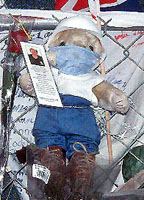|
Home India Slideshow India Travel: Planning & FAQ Photo Gallery |
|
|
Switzerland |
|
|
|
Delhi Rishikesh The Himalayas Mussourie Varanasi Delhi Again! Agra: Taj Mahal Udaipur Mt. Abu |
|
|
|
Bombay Bangalore Kochin Madras/Chennai Mahabalipurum Pondicherry Tiruvanamalai/ Ramanasramam Back Home! |
|
|
|
Email Me...
|
A Visit to the September 11th World Trade Center Disaster Site
Copyright © 2002 Phil Servedio. All rights reserved.
(Click on pix for a larger view)
“Ground Zero” and “Nine-Eleven” – these terms were forcefully injected into the American psyche, if not the world psyche, like the swift punch of a professional prize-fighter in September 2001. Certainly these terms are not new – “ground zero” is a generic term for large, man-made disasters, particularly regarding the nuclear blasts of Hiroshima and Nagasaki. And Nine-Eleven is synonymous with Nine-One-One, the call for distress. But unless one has been living in a cave recently, a vast number of people throughout the world will know exactly the meaning behind these phrases (and especially some who are still in caves, if you get my point…) – they have become instant textual icons or markers for that tragic event in September. “Ground Zero” commemorates the event in space or locality, while “9-11” commemorates it in time or temporally. The new universality of these phrases reminds me of the story of the famous British explorer, Dr. Livingstone (of “Dr. Livingstone, I presume?”), while walking through a jungle in the heart of Africa, comes upon a young man whistling Ravel's Bolero, miles from a symphony orchestra.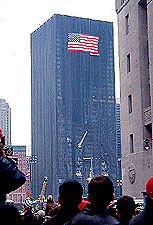
Having roots, as well all of my family, deep in the heart of New York, I decided to take a short trip this Christmas season to visit family, particularly to see my dad, whose health is suffering. And as soon as I decided upon making the trip, I planned on visiting Ground Zero. There was a mixture of feelings prompting this - a certain curiosity to experience a location of great global importance, a desire to show respect for the victims, an interest in seeing how the New Yorkers were living since the event, to bear witness to the tragedy, wanting to feel the pulse and energy of the area, to compare real life with television images, etc. In a sense, it was somewhat short of a religious pilgrimage, a personally motivated obligation and duty.
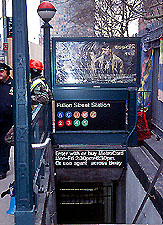 I asked my mom and sister if they wished to accompany me on the trip, and both were intent on going, even though they've been living just outside the city all this time…funny how one rarely or never goes to local “tourist” locations if one is a native – I spent ten years in Buffalo, NY and only went to see Niagara falls when I had visitors…In any case, my mom decided to not go due to her age, as it requires much walking around to see the site, but my sister and her two teenage daughters wanted to go. Additionally, the trip to Ground Zero would be an occasion for some quality time for my sister and me, separated by 3000 miles and busy schedules.
I asked my mom and sister if they wished to accompany me on the trip, and both were intent on going, even though they've been living just outside the city all this time…funny how one rarely or never goes to local “tourist” locations if one is a native – I spent ten years in Buffalo, NY and only went to see Niagara falls when I had visitors…In any case, my mom decided to not go due to her age, as it requires much walking around to see the site, but my sister and her two teenage daughters wanted to go. Additionally, the trip to Ground Zero would be an occasion for some quality time for my sister and me, separated by 3000 miles and busy schedules.
My flight to New York was my first since 9-11, and I had certain reservations about flying (American Airlines, JFK, yikes!), even though one is still 37 times more likely to be killed in a car accident than a plane crash, mile for mile, including the deaths from 9-11. Perhaps it's more about loss of control – in driving a car, one is seemingly at the command of his/her destiny, and much less likely that terrorists will rig a bomb under my 1990 Integra. But many lingering doubts were quelled when I saw the precautions at San Francisco airport – the security guards seemed to have their act much more together than before 9-11, new luggage scanning equipment, National Guard troops here and there. The scanning equipment was set to a much more sensitive level, picking up a key in my wallet and the metal buckle of my belt. And a guard did give me a very thorough and efficient scan and pat-down, in contrast to the typical ”I'd rather be doing something else for a living” effort prior to 9-11. I was even checked for under my belt buckle, a fairly good search for metal at the very least. But the guard did not check my sneakers for C-4! And God knows if the checked in bags were effectively scanned, or scanned at all! (apparently the company that builds the luggage scanners is heavily back-ordered). Whether it is a sign of ignorance or not, I am not sure, but I did feel very much at ease flying, knowing that a decent attempt is being made to improve airport security.
After arriving in New York, I went to visit my sister's family the night before we were to travel to Ground Zero, and my youngest niece asked me, with a guileless, inquisitive heart, “why do you want to go, uncle Phil?” The question was really about why would one want to go to a place associated with such heartbreak, pain, loss and sorrow – a young mind was trying to comprehend why adults do these kinds of things. In retrospect, I can clearly see why a young mind absorbed in an American culture obsessed with youth and the avoidance of death would ask such a question – a pilgrimage to Ground Zero flies in the face of what America is superficially 'about'.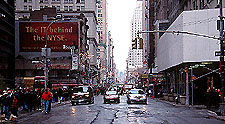
Similar to previous trips to Manhattan, I planned out our trip, taking the Long Island Railroad to Penn Station and making the connection on the A or E train to downtown on 'da subway'. And to my surprise, the train was packed, despite it being a Saturday – I wondered if there were many others on the train making the same pilgrimage to the sorrowful site. But once we found our seats, it afforded time to talk with my sister for some time, something that I relished. During our conversation, I looked out the window to see the northern half of the Manhattan skyline – it was a brisk and cold, but clear December day, and one can look right down the streets of Manhattan all the way to Jersey. The Citibank, Chrysler and Empire State Buildings still stood majestically and beautifully. However, at one point I saw an airliner apparently landing at La Guardia airport, but it only served to dredge up images of the planes smashing into the WTC towers. Since 9-11, the sight and sounds of large jet airliners in NYC will always have at least one dreaded association for many of us.
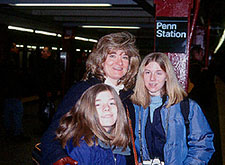 Arriving in Penn Station from the commuter train, you know that you've arrived in the Big Apple – the bustle, sights, sounds and yes, the smells of the big city hit you immediately as you walk through the underground city, in sharp contrast to the sleepy suburban town from where we embarked. After a quick meal of NYC pizza and detours of the bathroom at McDonalds on 34th St and camera stuff, we caught the A train downtown. The World Trade Center subway station, is of course closed, requiring one to get off at Chambers Street and walk a couple of blocks to Ground Zero.
Arriving in Penn Station from the commuter train, you know that you've arrived in the Big Apple – the bustle, sights, sounds and yes, the smells of the big city hit you immediately as you walk through the underground city, in sharp contrast to the sleepy suburban town from where we embarked. After a quick meal of NYC pizza and detours of the bathroom at McDonalds on 34th St and camera stuff, we caught the A train downtown. The World Trade Center subway station, is of course closed, requiring one to get off at Chambers Street and walk a couple of blocks to Ground Zero.
As we disembarked at Chambers St. my senses were heightened to notice any indications of the disaster. The station certainly had a strange 'burnt' smell, which my sister also noticed, but that could be from any number of unknown sources in a big city as New York. Arriving at the street level, it didn't take long to notice which direction to look, due to the location of the crowds. Being Saturday, any mob in the downtown area of Manhattan would surely be involved in only one thing – to visit the site of the disaster. People were clamoring to reach the top steps of a nearby building in order to get a better vantage point into the WTC site. 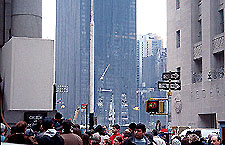
Through the canyon walls of downtown, there it was in real life, a large open and empty expanse where once stood the 3rd and 4th largest buildings in the world, now occupied with cranes, assorted piles of debris, and numerous vehicles and personnel going about their difficult work. I could see the cranes going about their digging and a nearby building on Liberty St. had a giant American flag draped on the side facing the site. There was a combination of senses in air; a sense of sadness, of doom, of sorrow as well as a sense of urgency in the crowd to get closer. Even though this was the worst attack in US history, people wanted to get near it, to touch it – perhaps it is some kind of innate mammalian trait to get near and even touch places of death – I am reminded how elephants touch the bones of their dead brethren with their trunks, and I felt a similar sense, to touch newly made hallowed ground, gruesome as it was.
Strikingly absent was the now famous exterior section of one of the towers that somehow managed to keep standing through all the chaos (I'm told that the height of that section was the height of the pile of debris around it). It has been moved and placed into safe storage, for possible use in a future memorial.
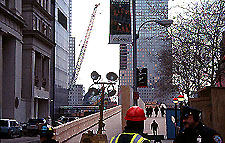 Having been more than 3 months since the disaster, the city has effectively cordoned off the area such that no one except specified personnel can get within a block of the site. This Saturday was also the supposed opening of a new vantage point to view the disaster – the first of four nicely build makeshift ramps to view the site from a higher vantage point. And the reason is simple – there has been so much excavation at the site, the debris is now at ground level for the most part, save for a few remaining piles.
Having been more than 3 months since the disaster, the city has effectively cordoned off the area such that no one except specified personnel can get within a block of the site. This Saturday was also the supposed opening of a new vantage point to view the disaster – the first of four nicely build makeshift ramps to view the site from a higher vantage point. And the reason is simple – there has been so much excavation at the site, the debris is now at ground level for the most part, save for a few remaining piles.
Additionally, a good deal of work has been done on the buildings surrounding the WTCs, to the point where it looks more like a construction site than a destruction site. However, it is the feeling of the somber sorrow that hangs over the area that makes it distinguishable from an ordinary construction site. The feeling makes it unmistakable, as I could feel the sorrow swell in my heart as we approached the site from the north. One immediate perception was that there was very little dust in the area surrounding the site – the city and perhaps the weather has done remarkably well in removing the tons of concrete dust and restoring downtown to its usual semi-clean vistas.
Another perception was that the area looked relatively bright, in that the sun blockage from two of the tallest building in the world is no longer there.
Many people remarked how huge the disaster site was (14 acres, I've been told), but I had a somewhat opposite point of view, that the disaster was remarkably small in size in relation to the hugeness of Manhattan, and NYC in general. I can only imagine the greater scale of the destruction had the buildings toppled sideways onto their smaller neighbors, which was apparently the intent of the 1993 bombing – looking at the neighborhood of tower behemoths, I was trying to gauge how large an area would be effected by the toppling of the 30 to 50 story neighbors, let alone 110 stories. And it still flabbergasts me that the buildings collapsed straight down on themselves, as if they were rigged for collapse by a professional demolition company. This has been one of many sources of controversy and discussions in various Internet chat rooms.
Looking south on Church St, I could see crowds moving about, unable to get any closer than a block away. At first I felt disoriented – I haven't spent any time at all in this part of Manhattan, as it is not much of a tourist area, save for the WTC buildings themselves (I went to the top in 1985, and though it is a remarkable view, it doesn't match the location of the Empire State building, which is smack in mid-town Manhattan).
 We decided to move over to Broadway, going east on Vesey Street and noticed the plethora of sidewalk vendors, selling the usual crap, such as imitation Rolex watches and designer sunglasses, as well as a whole new set of WTC paraphernalia: T-shirts, NYPD and NYFD hats, bumper stickers, gloves (did I mention that this is late December in New York, and it's freakin' cold, with a stiff breeze coming over from the Hudson?), as well as a very impressive assortment of artwork and photographs of the World Trade Center buildings from various angles. Initially, I felt like it was a bit of exploitation, making money off of what was such a heartbreaking event for so many. But I quickly let go of that judgment and enjoyed what were some very beautiful pieces of work, and eventually I did get a t-shirt for my wife,
We decided to move over to Broadway, going east on Vesey Street and noticed the plethora of sidewalk vendors, selling the usual crap, such as imitation Rolex watches and designer sunglasses, as well as a whole new set of WTC paraphernalia: T-shirts, NYPD and NYFD hats, bumper stickers, gloves (did I mention that this is late December in New York, and it's freakin' cold, with a stiff breeze coming over from the Hudson?), as well as a very impressive assortment of artwork and photographs of the World Trade Center buildings from various angles. Initially, I felt like it was a bit of exploitation, making money off of what was such a heartbreaking event for so many. But I quickly let go of that judgment and enjoyed what were some very beautiful pieces of work, and eventually I did get a t-shirt for my wife,
Rounding Vesey St and turning right onto Broadway (which runs the length of Manhattan, in case you did not know) put us right in front of St. Paul's church, an island of early American architecture amidst the behemoths of lower Manhattan. The church, the site of many a recent funeral, is surrounded by a spiked iron fence which hosts one of the now famous walls of commemoration to the victims of the disaster. 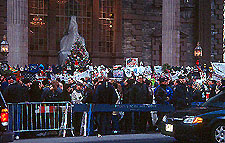
It's hard to describe the feeling there, it was one of such intensity. I can only compare it to what I felt when I walked around the Vietnam War Memorial in DC, piercing my heart with its import and significance. So many lives lost in such a short time – consider how long it would take to count to three-thousand. But in contrast to the Vietnam Memorial, this is a living memorial created ad hoc, not by a single architect, but by many, many people, pouring their heart out in very moving and very creative ways.
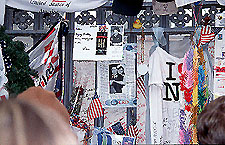 The variety of commemorations was impressive: t-shirts, US flags of various sizes (as well as the British Union Jack), colorful streamers, posters and banners from various parts of the country declaring their love for New York, baseball hats, hard hats, a profundity of flowers, children and adult artwork, teddy bears, prayer and memorial cards, photos of the victims (some with post-mortem birthday wishes) and other indefinable tributes. Particularly touching were the numerous baseball hats atop the spikes of the fence, representing some of the victims and some of the visitors from all over the country. Most of the space on the commemoration items had been taken up by written tributes by the original author and numerous passers-by, some specifically for a victim, but most were either patriotic messages, or messages of inspiration, and solace, bearing witness, all offerings straight from the heart, as you can see in the accompanying photos.
The variety of commemorations was impressive: t-shirts, US flags of various sizes (as well as the British Union Jack), colorful streamers, posters and banners from various parts of the country declaring their love for New York, baseball hats, hard hats, a profundity of flowers, children and adult artwork, teddy bears, prayer and memorial cards, photos of the victims (some with post-mortem birthday wishes) and other indefinable tributes. Particularly touching were the numerous baseball hats atop the spikes of the fence, representing some of the victims and some of the visitors from all over the country. Most of the space on the commemoration items had been taken up by written tributes by the original author and numerous passers-by, some specifically for a victim, but most were either patriotic messages, or messages of inspiration, and solace, bearing witness, all offerings straight from the heart, as you can see in the accompanying photos.
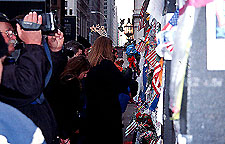 And there were plenty of passers-by. The crowd filing past the memorial was sometimes ten people deep, as people slowly walked by the wall of sorrow, reading the tributes, taking in the energy, having their hearts broken by the outpouring of affection found there. Many were sobbing, and almost all were in a mood conducive to attending to an important and meaningful memorial. There were the occasional character or two in a typical New York rush, and several folks attempted to climb on light poles and various barricades, trying to get a better view or photo of the destruction, only to be reprimanded by a New York cop in brusque fashion (the way it's done in New York). I did feel sorry for the police a bit, having to play playground attendant to adults, “hey you, get awff of that, now!”
And there were plenty of passers-by. The crowd filing past the memorial was sometimes ten people deep, as people slowly walked by the wall of sorrow, reading the tributes, taking in the energy, having their hearts broken by the outpouring of affection found there. Many were sobbing, and almost all were in a mood conducive to attending to an important and meaningful memorial. There were the occasional character or two in a typical New York rush, and several folks attempted to climb on light poles and various barricades, trying to get a better view or photo of the destruction, only to be reprimanded by a New York cop in brusque fashion (the way it's done in New York). I did feel sorry for the police a bit, having to play playground attendant to adults, “hey you, get awff of that, now!”
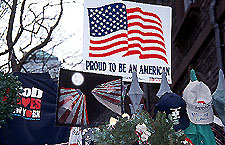 It took a while to file past the entire memorial in front of St Paul's Church, but no one was in a hurry. You were already there at your destination, as this is part of Ground Zero, no doubt. But I did want to move to a location where it wasn't so crowded, and perhaps right next to the site. At the south end of the church is Fulton St. and this is the site of one of the four new ramps to view the WTC cleanup work. These ramps were designed by a group of architects pro bono, of simple but elegant plywood construction, and we arrived just before Mayor Guiliani came to officially open the ramps (unfortunately for us, this first ramp was to be open to the public on the next day). However, as we looked down Fulton St, we could get a different vantage point of the disaster site, looking directly west, facing the “Winter Garden” building which are to the west of the WTC site. Much of the lower buildings had severe damage, but by this point, it looked like a building under effective re-construction. I noticed that Fulton St. looked fairly clean (well, as clean as Manhattan is ordinarily), no concrete dust, and hardly a smell. My sister asked me if I smelled anything that may have been from the disaster and I replied, “no, nothing unusual, just the usual smell coming from Jersey.”
It took a while to file past the entire memorial in front of St Paul's Church, but no one was in a hurry. You were already there at your destination, as this is part of Ground Zero, no doubt. But I did want to move to a location where it wasn't so crowded, and perhaps right next to the site. At the south end of the church is Fulton St. and this is the site of one of the four new ramps to view the WTC cleanup work. These ramps were designed by a group of architects pro bono, of simple but elegant plywood construction, and we arrived just before Mayor Guiliani came to officially open the ramps (unfortunately for us, this first ramp was to be open to the public on the next day). However, as we looked down Fulton St, we could get a different vantage point of the disaster site, looking directly west, facing the “Winter Garden” building which are to the west of the WTC site. Much of the lower buildings had severe damage, but by this point, it looked like a building under effective re-construction. I noticed that Fulton St. looked fairly clean (well, as clean as Manhattan is ordinarily), no concrete dust, and hardly a smell. My sister asked me if I smelled anything that may have been from the disaster and I replied, “no, nothing unusual, just the usual smell coming from Jersey.”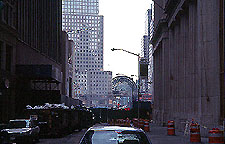
Note: Being a native New Yawker, I consider it my sworn duty and obligation to poke fun at New Jersey whenever possible. That's the reason why New Jersey exists! Actually, it's not 'New Jersey' but simply 'Jersey', making most efficient use of the language for the time sensitive New Yawker. But seriously, many Jerseyites were victims in the disaster, and the good people across the Hudson were there for their brothers and sisters in Manhattan when they were needed. Kevin Smith, a Jerseyite and of Clerks and Chasing Amy fame did a wonderfully funny and moving short documentary on how New Yawkers really felt about their Jerseyite neighbors in the wake of September 11th ('If Jersey is the garden state, then where the fuck are the gardens?').
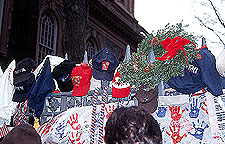 Many camera crews were arriving, being allowed through the police barricades to photograph the upcoming commemoration. Little did we know that some of the cameras were pointed at us – when I watched the 6 o'clock news on TV later that day, there was my sister and her daughters on television! While we were standing near the now-closed Fulton St subway station entrance, a group of New York Fireman showed up, obviously rescue workers at the site. They had quite a presence in their black cloaks and sandhog uniforms, and as they walked towards the site, people began to clap in appreciation for their difficult and seemingly never-ending task.
Many camera crews were arriving, being allowed through the police barricades to photograph the upcoming commemoration. Little did we know that some of the cameras were pointed at us – when I watched the 6 o'clock news on TV later that day, there was my sister and her daughters on television! While we were standing near the now-closed Fulton St subway station entrance, a group of New York Fireman showed up, obviously rescue workers at the site. They had quite a presence in their black cloaks and sandhog uniforms, and as they walked towards the site, people began to clap in appreciation for their difficult and seemingly never-ending task.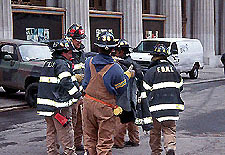
We moved further south down Broadway, to what was once Liberty Plaza, there was another wall of tribute to the victims of September 11th, as well as new vantage points to look at the site via Cortland and Liberty streets. This commemoration site seemed even more full of creative effort than the one at St. Paul's street. One of my favorite tributes was a small teddy bear dressed in a rescue worker's uniform, complete with boots, hard hat and surgical mask, carrying a memorial card of one of the victims.
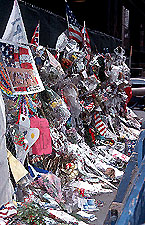 This may sound silly, but what really sent me over the edge into the land of tears was a t-shirt that read 'Texas loves New York'. Texas loves New York - something really has changed, hasn't it? I always thought that Texans were madly in love with one and only one thing, and that was Texas. And those folks, who perhaps best exemplify the icon of the brash, outspoken, loud and sometimes overbearing ugly American, softly whispered that they too love New York. Whatever silly differences between the states was burned up in the giant ash heaps of the north and south towers, leaving only a sense of love between fellow Americans that normally don't take too kindly to each other. Texans found a way to see past their own love affair with their state, and spread the love around a bit. That was huge.
This may sound silly, but what really sent me over the edge into the land of tears was a t-shirt that read 'Texas loves New York'. Texas loves New York - something really has changed, hasn't it? I always thought that Texans were madly in love with one and only one thing, and that was Texas. And those folks, who perhaps best exemplify the icon of the brash, outspoken, loud and sometimes overbearing ugly American, softly whispered that they too love New York. Whatever silly differences between the states was burned up in the giant ash heaps of the north and south towers, leaving only a sense of love between fellow Americans that normally don't take too kindly to each other. Texans found a way to see past their own love affair with their state, and spread the love around a bit. That was huge.
The crowd was considerably thinner at this site, and we spent more time reading the tributes as the late afternoon sun finally broke through, brightening up the floors of the New York canyons. But despite the sun's appearance, the temperature was dropping and we had to fulfill my sister's promise to take her daughters to Rockefeller center in midtown Manhattan, an obligatory tourist destination for New York at Christmas time. As we crossed Broadway, the sun was shining beautifully on the west face of City Hall (only a couple of blocks from Ground Zero), and we could feel that we were out of a certain 'zone of presence' that Ground Zero radiates, being the site of many a victim and the focus of a significant part of the world's psyche in recent months.
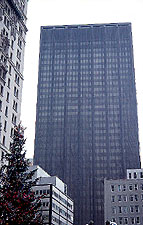 Taking the A-train back to midtown and walking around Rockefeller center, with the all familiar angels, skating rink and massive Christmas tree, the mood was significantly different, evoking a magical feeling that is quite normal for Christmas time in Manhattan – I remember my first visit there at 4 years of age, and my first hot-chocolate in a New York deli, a moment in time that I'll never forget. But somehow, despite its magic and beauty, compared to Ground Zero, it seemed somewhat superficial and laid on, so “September 10th” as the saying goes. The real heart and deep vortex has now unexpectedly shifted 50 blocks south, to an area of Manhattan not known for much heart, a place that holds City Hall, Wall Street and the brutal center of free-market capitalism.
Taking the A-train back to midtown and walking around Rockefeller center, with the all familiar angels, skating rink and massive Christmas tree, the mood was significantly different, evoking a magical feeling that is quite normal for Christmas time in Manhattan – I remember my first visit there at 4 years of age, and my first hot-chocolate in a New York deli, a moment in time that I'll never forget. But somehow, despite its magic and beauty, compared to Ground Zero, it seemed somewhat superficial and laid on, so “September 10th” as the saying goes. The real heart and deep vortex has now unexpectedly shifted 50 blocks south, to an area of Manhattan not known for much heart, a place that holds City Hall, Wall Street and the brutal center of free-market capitalism.
But for many, if not most people, it takes a personal crisis or large-scale disaster to stop certain momentums and expose a heart that speaks of unity instead of differences and love and joy, instead of fear, hate, greed, anger and sorrow. And that heart now has been exposed in downtown Manhattan, amidst the concrete jungle, towering giants and hyper-busy urbanity. A wake up call has occurred, and from the ashes of disaster, something wonderful has been aroused. And if the heart can be found there, in the most unlikely of places it can be found anywhere, in your life and mine.
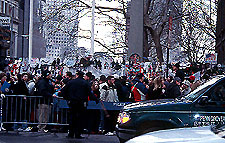 New Yorkers stereotypically are not known for their gentleness or soft-hearted sentiment. But that does not mean that they're lacking in heart, and it took a major disaster to bring it out in full force. Just for example, when I left NYC to fly back home, I took a bus from Queens to JFK airport, the Q3 on Hillside Avenue. I asked an African American brother at the bus stop if this was the right bus to JFK and we struck up a short conversation (mostly about how cold it was!). While going through Brooklyn, as the fellow got off at his stop, he paused for a moment and spoke to me across the bus, 'have a good trip home'.
New Yorkers stereotypically are not known for their gentleness or soft-hearted sentiment. But that does not mean that they're lacking in heart, and it took a major disaster to bring it out in full force. Just for example, when I left NYC to fly back home, I took a bus from Queens to JFK airport, the Q3 on Hillside Avenue. I asked an African American brother at the bus stop if this was the right bus to JFK and we struck up a short conversation (mostly about how cold it was!). While going through Brooklyn, as the fellow got off at his stop, he paused for a moment and spoke to me across the bus, 'have a good trip home'.
 I was taken aback by his kind words and sentiment. Perhaps New York has changed since September 11th, but in my opinion, in a different way than what one would think. To me, the kindness, heart and generosity was always there in New Yorkers, it was just covered over in the busy-ness of densely packed urban living. But September 11th cut through all of that and reordered priorities in a deep way. Just like the man on the bus, there is a great deal of well-wishing in the city that's thought to be cruel and harsh. Sometimes it takes a big and awful moment to expose the heart that always has been there. May that deep heart continue being the living center of our lives and the source of communication with each other.
I was taken aback by his kind words and sentiment. Perhaps New York has changed since September 11th, but in my opinion, in a different way than what one would think. To me, the kindness, heart and generosity was always there in New Yorkers, it was just covered over in the busy-ness of densely packed urban living. But September 11th cut through all of that and reordered priorities in a deep way. Just like the man on the bus, there is a great deal of well-wishing in the city that's thought to be cruel and harsh. Sometimes it takes a big and awful moment to expose the heart that always has been there. May that deep heart continue being the living center of our lives and the source of communication with each other.
-January 02, 2002
